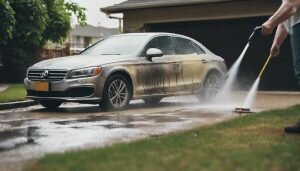Choosing the Right Products
- Avoid generic products, check ingredients, and test first.
- Opt for material-specific, essential-label items.
Cleaning the Exterior
- Use warm water and car-safe soap, non-abrasive sponge, and rinse frequently.
- Remove bugs with bug spray and tar using tar remover.
Polishing and Waxing
- Pick non-abrasive polish suitable for your paint.
- Use Carnauba or synthetic wax from trusted brands for a glossy finish.
Caring for the Interior
- Clean leather with gentle leather cleaner, vacuum first, and condition.
- Use mild soap for upholstery, avoid harsh chemicals, and control humidity.
Maintaining your classic car involves more steps essential to preserving its value and aesthetics.
Choosing the Right Products

When detailing a classic car, it's important to choose products specifically designed for vintage automobiles. These cars often have unique finishes and materials that require special care. Using the wrong products can damage the car's appearance and decrease its value.
Product Selection
Selecting the right products involves understanding the specific needs of your classic car. Modern cleaning solutions may contain chemicals that are too important for older paint or upholstery. Look for products labeled as safe for vintage cars, or those formulated for specific materials like chrome, leather, or classic paint finishes.
Chemical Safety
Chemical safety is essential when working with cleaning products. Always read the labels and follow the manufacturer's instructions. Some chemicals can cause harm if they come into contact with your skin or eyes. Additionally, make sure you're working in a well-ventilated area to avoid inhaling any fumes.
- Avoid Generic Products: They might not be formulated for vintage cars.
- Check Ingredients: Ensure they are safe for older materials.
- Test First: Always test a small area before applying widely.
Cleaning the Exterior
To properly clean the exterior of your classic car, start by gently rinsing off any loose dirt and debris using a hose with a soft spray nozzle. This initial step helps guarantee scratches when you begin the hands-on cleaning process.
Bug Removal
- Use a specialized bug remover spray. Apply it directly onto the affected areas.
- Let the product sit for a few minutes to break down the bug residue.
- Use a microfiber cloth to gently wipe away the bugs. Avoid scrubbing too hard to prevent damaging the paint.
Tar Cleaning
- Apply a tar remover to any spots with tar.
- Allow the solution to work for the recommended amount of time.
- Gently wipe off the dissolved tar using a clean microfiber cloth.
- Rinse the area thoroughly with water to remove any residue from the cleaning products.
Washing the Car
- Fill a bucket with warm water and add a car-safe soap.
- Use a soft, non-abrasive sponge to wash the car, starting from the top and working your way down.
- Rinse the sponge frequently to avoid spreading dirt.
- After washing, rinse the entire car with clean water.
Following these steps guarantees that your classic car's exterior remains in pristine condition without damaging the paint.
Polishing and Waxing

Polishing and waxing your classic car is essential, not just for shine but also for protection. You'll need to choose the right products to avoid damaging the paintwork, and apply specific techniques to achieve an ideal finish. Let's explore how to select the best polish and wax, the proper application methods, and how to maintain your car's appearance and durability.
Choosing the Right Products
Choosing the Right Products
How do you select the best products for polishing and waxing your classic car to make sure it maintains its timeless shine? Product selection is important for preserving your vehicle's beauty and value. Start by investing in high-quality detailing tools, as they'll make the process more efficient. Look for soft, microfiber cloths and applicator pads, which are gentle on the car's surface.
Polishing Products
When choosing a polish, consider the type of paint on your classic car. Older vehicles often have single-stage paint, which requires a different polish than modern clear coats. Opt for a non-abrasive polish to avoid damaging the paint. Brands like Meguiar's and 3M offer reliable options.
Waxing Products
Waxing protects the paint and adds a glossy finish. Carnauba wax is a popular choice for classic cars because it provides a deep, rich shine. Synthetic waxes also offer excellent protection and longevity. Brands like P21S and Collinite are trusted by many classic car enthusiasts.
Technique for Optimal Shine
Once you've selected the right products, mastering the technique for polishing and waxing is key to achieving that perfect shine for your classic car. Start by washing and drying your car thoroughly. Next, choose a high-quality polish to remove minor imperfections and enhance the paint's clarity. Apply the polish with a foam applicator pad, working in small sections using circular motions.
Buffing Techniques
- Initial Buffing: Use a dual-action polisher at a low speed to spread the polish evenly.
- Final Buffing: Increase the speed slightly, ensuring even coverage and removing any excess product.
- Hand Buffing: For tighter areas, use a microfiber cloth to buff by hand, maintaining consistent pressure.
Waxing for Shine
After polishing, it's time to wax. Select a premium carnauba wax for a deep, lasting shine. Apply the wax using a clean foam applicator pad in a thin, even layer. Let it haze over, usually for about 5-10 minutes.
Buffing the Wax
- Microfiber Cloths: Use fresh, clean microfiber cloths to remove the wax, working in a linear motion to avoid swirl marks.
- Final Touch: Buff the entire car with another microfiber cloth, ensuring a streak-free finish.
Protecting the Paintwork
Protecting the Paintwork
Regularly maintaining your classic car's paintwork with proper polishing and waxing techniques not only enhances its appearance but also provides essential protection against environmental damage. By understanding the importance of these steps, you can keep your vehicle in pristine condition.
Polishing
- Prevents Rust: Polishing removes surface imperfections and contaminants that can lead to rust. Use a high-quality polish to gently buff out scratches and oxidation. This process not only restores the paint's original luster but also creates a smooth surface.
- Avoids Sunfade: Regular polishing helps in reducing the effects of UV rays on your car's paint. By removing dull and oxidized layers, you safeguard the paint remains vibrant and less susceptible to sunfade.
Waxing
- Creates a Protective Barrier: Waxing adds a layer of protection that shields your car's paint from moisture, dirt, and other contaminants. This barrier is vital for preventing rust.
- Maintains Shine: A good wax maintains the polished look and enhances the paint's depth and clarity. This step is essential for avoiding sunfade and keeping the car's color looking fresh.
Caring for the Interior
To properly care for the interior of your classic car, you need to focus on cleaning leather seats and preserving the original upholstery. Regularly clean and condition leather seats to prevent cracking and fading. Also, take steps to protect and maintain the original upholstery, ensuring it stays in great condition for years to come.
Cleaning Leather Seats
Cleaning Leather Seats
When cleaning leather seats, it's important to use a gentle cleaner specifically designed for leather to avoid damaging the material. Begin by vacuuming any loose dirt or debris from the seat surfaces. This step ensures that dirt doesn't get rubbed into the leather during the cleaning process.
Stain Removal
- Identify Stains: Examine the seats for any noticeable stains.
- Apply Cleaner: Use a soft cloth to apply the leather cleaner. Gently rub the cleaner into the stained areas.
- Wipe Off: After allowing the cleaner to sit for a few minutes, wipe it off with a clean, dry cloth.
Leather Hydration
Maintaining leather hydration is important to prevent cracking and maintain the seat's suppleness.
- Condition the Leather: After cleaning, apply a leather conditioner. Use a separate, clean cloth for this step.
- Even Application: Spread the conditioner evenly over the seats, ensuring all areas are covered.
- Dry and Buff: Let the conditioner absorb into the leather for a few minutes, then buff the seats with another dry cloth to remove any excess product.
Regular Maintenance
To keep your classic car's leather seats in top condition, repeat this cleaning and conditioning process every few months. This routine will help preserve the leather's natural texture and appearance.
Preserving Original Upholstery
Preserving Original Upholstery
Preserving the original upholstery in your classic car involves gentle cleaning and proper protection to maintain its historical value and aesthetic appeal. Start by vacuuming the seats and carpets thoroughly to remove loose dirt and debris. Use a soft brush attachment to avoid damaging delicate fabrics.
Cleaning Techniques
- Mild Soap Solution: Mix mild soap with water for spot cleaning. Avoid harsh chemicals that can degrade the material.
- Microfiber Cloths: Use microfiber cloths to gently scrub the upholstery, ensuring you don't cause any wear or tear.
Protection Methods
- Humidity Control: Keep your car in an environment where humidity is controlled. Excessive moisture can lead to mold growth and fabric deterioration. Use a dehumidifier if necessary.
- UV Protection: Protect your upholstery from UV rays by parking in shaded areas or using a car cover. UV rays can cause fabric fading and weakening over time. Consider window tints for additional UV protection.
Regular Maintenance
- Conditioning Products: Use upholstery-specific conditioners to keep the material supple and prevent cracking.
- Frequent Inspections: Regularly inspect your upholstery for signs of wear, stains, or fading. Address issues promptly to prevent further damage.
Protecting the Engine Bay

Protecting the Engine Bay
Consistently safeguarding the engine bay is essential for maintaining the performance and longevity of your classic car. Start by focusing on rust prevention, as rust can cause significant damage over time. Use a rust inhibitor spray on metal surfaces to maintain corrosion at bay. Guarantee thorough coverage, especially in crevices and seams where moisture tends to accumulate.
Electrical Components
Next, pay attention to the electrical components. Classic cars often have older wiring systems that can be susceptible to wear and tear. Regularly inspect the wiring for any signs of fraying or corrosion. Use dielectric grease on electrical connectors to prevent moisture from causing shorts or other issues. Additionally, make sure the battery terminals are clean and free of corrosion by using a battery terminal cleaner.
Cleaning
When cleaning the engine bay, use a gentle degreaser to remove grime and oil. Avoid using high-pressure water, as it can force water into sensitive areas and cause damage. Instead, use a soft brush and microfiber cloths to clean surfaces. Once clean, apply a silicone-based protectant to rubber hoses and plastic components to keep them flexible and prevent cracking.
Maintaining the Wheels and Tires
Guaranteeing the wheels and tires of your classic car are in top condition is essential for both safety and aesthetics. Proper maintenance can extend the lifespan of your vehicle and enhance its performance. Here are key aspects to contemplate:
Tire Pressure
- Check Regularly: Always inspect your tire pressure monthly. Under-inflated tires can lead to poor gas mileage and uneven wear.
- Use a Reliable Gauge: Invest in a high-quality tire pressure gauge. The correct pressure can usually be found in the car's manual.
- Adjust as Needed: If the pressure is too low or high, adjust accordingly. Consistent tire pressure helps ensure smooth rides and longevity.
Wheel Alignment
- Inspect Alignment: Regularly examine your wheel alignment. Misalignment can cause uneven tire wear and affect handling.
- Professional Service: Have your alignment checked by a professional if you notice your car pulling to one side or if the steering wheel isn't centered.
- Frequency: It's wise to have your wheel alignment checked annually or whenever you replace your tires.
Cleaning and Protection
- Regular Cleaning: Clean your wheels and tires frequently to remove brake dust and road grime. Use a non-acidic cleaner to prevent damage.
- Tire Dressing: Apply a tire dressing to protect rubber from UV rays and cracking.
Storing Your Classic Car

After guaranteeing your wheels and tires are in top shape, it's important to store your classic car properly to preserve its condition. Here are some key points to keep in mind:
Temperature Control
Maintaining a stable temperature is vital. Classic cars are sensitive to extreme temperatures, which can cause damage to the paint and interior. Ideally, store your car in a climate-controlled garage. If that's not possible, use a high-quality car cover to protect it from temperature fluctuations.
Humidity Management
High humidity levels can lead to rust and mold, damaging both the exterior and interior. Use a dehumidifier in your storage space to keep humidity levels low. Aim for a humidity level between 40% and 50%. Additionally, consider using moisture-absorbing packets inside the car to further reduce humidity.
Other Considerations
- Ventilation: Ensure your storage area is well-ventilated to prevent dampness.
- Elevate Tires: Use tire cradles or jack stands to take the weight off the tires, preventing flat spots.
- Battery Maintenance: Disconnect the battery or use a trickle charger to keep it in good condition.
- Fuel Stabilizer: Add a fuel stabilizer to prevent fuel degradation.





